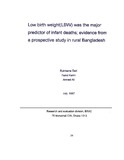Low birth weight(LBW) was the major predictor of infant deaths: evidence from a prospective study in rural Bangladesh
Abstract
The study was the part of a longitudinal study on the consequences of low birth
weight babies (LBW) in three unions of Manikganj district in Bangladesh. The
study aimed to estimate the infant mortality rate In title study population ·and to
identify the causes and factors related to infant deaths. Data was collected during
1993-1994. In this study pregnant mothers were registered at the third trimester of
pregnancy. After delivery birth weights of a total 644 infants were recorded. The
infants received monthly follow-up visits ti ll 1 year of age. All deaths during followup
period were recorded. Low birth weight was identified as being the commonest
factor contributing to infant deaths. Diarrhoeal disorder and ARI were major killer
diseases. Poor weight gain by the mothers during pregnancy, multiparity, low
education of parents, poor living condition were found to be linked with infant
deaths. Detrimental feeding practices were prevalent among the mothers. It is
important to provide information to all members of the community about
consequences, prevention and care of LBW.

